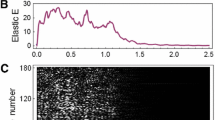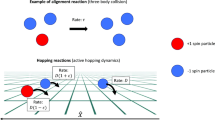Abstract
In this paper, we study a flocking dynamics of the deterministic inertial spin (IS) model. The IS model was introduced for the collective dynamics of active particles with an internal angular momentum, or spin. When the generalized moment of inertia becomes negligible compared to spin dissipation (overdamped limit) and mutual communication weight is a function of a relative distance between interacting particles, the deterministic inertial spin model formally reduces to the Cucker–Smale (CS) model with constant speed constraint whose emergent dynamics has been extensively studied in the previous literature. We present several sufficient frameworks leading to the asymptotic mono-cluster flocking, in which spins and relative velocities tend to zero asymptotically. We also provide several numerical simulations for the decoupled and coupled inertial spin models to see the effect of the C–S velocity flocking and compare them with our analytical results.










Similar content being viewed by others
References
Ahn, S.M., Choi, H., Ha, S.-Y., Lee, H.: On collision-avoiding initial configurations to Cucker–Smale type flocking models. Commun. Math. Sci. 10, 625–643 (2012)
Attanasi, A., Cavagna, A., Del Castello, L., Giardina, I., Jelic, A., Melillo, S., Parisi, L., Shen, E., Viale, M.: Information transfer and behavioural inertia in starling focks. Nat. Phys. 10, 691–696 (2014)
Barbǎlat, I.: Systèmes déquations différentielles doscillations non Linéaires. Rev. Math. Pures Appl. 4, 267–270 (1959)
Carrillo, J.A., Orsogna, M.R.D., Panferov, V.: Double milling in self-propelled swarms from kinetic theory. Kinet. Relat. Models 2, 363–378 (2009)
Carrillo, J.A., Fornasier, M., Rosado, J., Toscani, G.: Asymptotic flocking dynamics for the kinetic Cucker–Smale model. SIAM. J. Math. Anal. 42, 218–236 (2010)
Cavagna, A., Cimarelli, A., Giardina, I., Parisi, G., Santagati, R., Stefanini, F., Viale, M.: Scale-free correlations in starling flocks. Proc. Natl. Acad. Sci. USA 107, 11865–11870 (2010)
Cavagna, A., Castello, L.D., Giardina, I., Grigera, T., Jelic, A., Melillo, S., Mora, T., Parisi, L., Silvestri, E., Viale, M., Walczak, A.M.: Flocking and turning: a new model for self-organized collective motion. J. Stat. Phys. 158, 601–627 (2015)
Chat, H., Ginelli, F., Grgoire, G., Peruani, F., Raynaud, F.: Modeling collective motion: variations on the Vicsek model. Eur. Phys. J. B 64, 451–456 (2008)
Chi, D., Choi, S.-H., Ha, S.-Y.: Emergent behaviors of a holonomic particle system on a sphere. J. Math. Phys. 55, 052703 (2014)
Cho, J., Ha, S.-Y., Huang, F., Jin, C., Ko, D.: Emergence of bi-cluster flocking for agent-based models with unit speed constraint. Anal. Appl. (Singap.) 14, 39–73 (2016)
Choi, S.-H., Ha, S.-Y.: Emergence of flocking for a multi-agent system moving with constant speed. Commun. Math. Sci. 14, 953–972 (2016)
Choi, S.-H., Ha, S.-Y.: Interplay of the unit-speed constraint and time-delay in Cucker-Smale flocking. J. Math. Phys. 59(8), 082701 (2018)
Chuang, Y.-L., D’Orsogna, M.R., Marthaler, D., Bertozzi, A.L., Chayes, L.S.: State transitions and the continuum limit for a 2D interacting, self-propelled particle system. Phys. D 232, 33–47 (2007)
Cucker, F., Smale, S.: On the mathematics of emergence. Jpn. J. Math. 2, 197–227 (2007a)
Cucker, F., Smale, S.: Emergent behavior in flocks. IEEE Trans. Autom. Control 52, 852–862 (2007b)
D’O’rsogna, M.R., Chuang, Y.-L., Bertozzi, A.L., Chayes, L.S.: Self-propelled particles with soft-core interactions: patterns, stability, and collapse. Phys. Rev. Lett. 96, 104302 (2006)
Degond, P., Motsch, S.: Macroscopic limit of self-driven particles with orientation interaction. C. R. Math. Acad. Sci. Paris 345, 555–560 (2007)
Degond, P., Motsch, S.: Large-scale dynamics of the persistent turing Walker model of fish behavior. J. Stat. Phys. 131, 989–1022 (2008a)
Degond, P., Motsch, S.: Continuum limit of self-driven particles with orientation interaction. Math. Models Methods Appl. Sci. 18, 1193–1215 (2008b)
Degond, P., Liu, J.-G., Motsch, S., Panferov, V.: Hydrodynamic models of self-organized dynamics: derivation and existence theory. Methods Appl. Anal. 20(2), 89–114 (2013)
Dubovskii, P.B.: Mathematical Theory of Coagulation. Lecture Notes Series, vol. 23. Seoul National University, Research Institute of Mathematics, Global Analysis Research Center, Seoul (1994)
Erdmann, U., Ebeling, W., Mikhailov, A.: Noise-induced transition from translational to rotational motion of swarms. Phys. Rev. E 71, 051904 (2005)
Fetecau, R.C., Eftimie, R.: An investigation of a nonlocal hyperbolic model for self-organization of biological groups. J. Math. Biol. 61, 545–579 (2010)
Frouvelle, A., Liu, J.-G.: Dynamics in a kinetic model of oriented particles with phase transition. SIAM J. Math. Anal. 44, 791826 (2012)
Grégoire, G., Chaté, H., Tu, Y.: Moving and staying together without a leader. Phys. D 181, 157–170 (2003)
Ha, S.-Y., Liu, J.-G.: A simple proof of Cucker–Smale flocking dynamics and mean field limit. Commun. Math. Sci. 7, 297–325 (2009)
Ha, S.-Y., Ruggeri, T.: Emergent dynamics of a thermodynamically consistent particle model. Arch. Ration. Mech. Anal. 223, 1397–1425 (2017)
Ha, S.-Y., Tadmor, E.: From particle to kinetic and hydrodynamic description of flocking. Kinet. Relat. Models 1, 415–435 (2008)
Ha, S.-Y., Ha, T., Kim, J.-H.: Asymptotic flocking dynamics for the Cucker–Smale model with the Rayleigh friction. J. Phys. A Math. Theor. 43, 315201 (2010a)
Ha, S.-Y., Ha, T., Kim, J.-H.: Emergent behavior of a Cucker–Smale type particle model with nonlinear velocity couplings. IEEE Trans. Autom. Control 55, 1679–1683 (2010b)
Ha, S.-Y., Jeong, E., Kang, M.-J.: Emergent behavior of a generalized Vicsek-type flocking model. Nonlinearity 23, 3139–3156 (2010c)
Ha, S.-Y., Ko, D., Zhang, Y.: Remarks on the critical coupling strength for the Cucker–Smale model with unit speed. Discrete Contin. Dyn. Syst. 38, 2763–2793 (2018)
Jadbabaie, A., Lin, J., Morse, A.S.: Coordination of groups of mobile autonomous agents using nearest neighbor rules. IEEE Trans. Autom. Control 48, 988–1001 (2003)
Justh, E., Krishnaprasad, P.A.: A simple control law for UAV formation flying. Technical Report 2002–38. Institute for Systems Research, University of Maryland, College Park, MD (2002)
Justh, E., Krishnaprasad, P.A.: Steering laws and continuum models for planar formations. In: Proceedings of the 42nd IEEE Conference on Decision and Control, pp. 3609–3615 (2003)
Leonard, N.E., Paley, D.A., Lekien, F., Sepulchre, R., Fratantoni, D.M., Davis, R.E.: Collective motion, sensor networks and ocean sampling. Proc. IEEE 95, 48–74 (2007)
Levine, H., Rappel, W.-J., Cohen, I.: Self-organization in systems of self-propelled particles. Phys. Rev. E 63, 017101 (2000)
Motsch, S., Tadmor, E.: A new model for self-organized dynamics and its flocking behavior. J. Stat. Phys. 144, 923–947 (2011)
Mikhailov, A.S., Zanette, D.H.: Noise-induced breakdown of coherent collective motion in swarms. Phys. Rev. E 60, 4571–4575 (1999)
Nguyen, N.H.P., Jankowski, E., Glotzer, S.C.: Thermal and athermal three-dimensional swarms of self-propelled particles. Phys. Rev. E 86, 011136 (2012)
Paley, D.A., Leonard, N.E., Sepulchre, R., Grunbaum, D., Parrish, J.K.: Oscillator models and collective motion: spatial patterns in the dynamics of engineered and biological networks. IEEE Control Syst. Mag. 27, 89–105 (2007)
Paley, D.A., Leonard, N.E., Sepulchre, R.: Stabilization of symmetric formations to motion around convex loops. Syst. Control Lett. 57, 209–215 (2008)
Peruani, F., Deutsch, A., Bär, M.: A mean-field theory for self-propelled particles interacting by velocity alignment mechanisms. Eur. Phys. J. Spec. Top. 157, 111–122 (2008)
Ren, W., Beard, R.W.: Consensus seeking in multi-agent systems under dynamically changing interaction topologies. IEEE Trans. Autom. Control 50, 655–661 (2005)
Toner, J., Tu, Y.: Flocks, herds, and schools: a quantitative theory of flocking. Phys. Rev. E 58, 4828 (1998)
Topaz, C.M., Bertozzi, A.L.: Swarming patterns in a two-dimensional kinematic model for biological groups. SIAM J. Appl. Math. 65, 152–174 (2004)
Vicsek, T., Czirók, A., Ben-Jacob, E., Cohen, I., Schochet, O.: Novel type of phase transition in a system of self-driven particles. Phys. Rev. Lett. 75, 1226–1229 (1995)
Author information
Authors and Affiliations
Corresponding author
Additional information
Communicated by Paul Newton.
The work of S.-Y. Ha was supported by National Research Foundation of Korea (NRF-2017R1A2B2001864).
Appendix A: Proof of Proposition 4.3
Appendix A: Proof of Proposition 4.3
First, we define \(\mathcal {E}^\infty \) and \(\bar{w}_c^\infty \) as the limits of \(\mathcal {E}\) and \(|{\bar{w}}_c|\), respectively.
-
Step A [convergence of (V, S)] By letting \(t\rightarrow \infty \) in Proposition 4.2, we have
$$\begin{aligned} {\mathcal {E}}^\infty + \frac{4\gamma }{\chi ^2 \kappa } \int _0^\infty {\mathcal {S}}(u)\mathrm{d}u = {\mathcal {E}}(t) + \frac{2}{\chi \kappa }{\mathcal {S}}(t) + \frac{4\gamma }{\chi ^2\kappa }\int _0^t {\mathcal {S}}(u)\mathrm{d}u. \end{aligned}$$
This can be rewritten as
Hence, we have
Since we assume \({\bar{w}}_c^\infty =0\) in Proposition 4.4, we have
If we define
then (A.1) becomes
This implies
On the other hand, since the following relation holds:
we obtain
Thus, we have
From the relation \(\chi |\dot{w}_i| = p_i|s_i|\) in (4.21)\(_1\), this is equivalent with
We use Hölder’s inequality to obtain
Hence, for each i, there exists \((w_i^k)^\infty \in \mathbb {R}\) such that
Thus, (V, S) converges to \((V^\infty ,S^\infty ):=(\frac{w_1^\infty }{p_1},\ldots ,\frac{w_N^\infty }{p_N},0,\ldots ,0)\).
-
Step B (linear stability analysis): Now, we show that \((V^\infty ,S^\infty )\) is linearly unstable. For this, we write
$$\begin{aligned} {\mathcal {I}}= & {} (v_1,\ldots ,v_N, s_1,\ldots ,s_N) \in \mathbb {R}^{6N}~~\text {and}~~ w_i=(w_i^1,w_i^2,w_i^3) \in \mathbb {R}^3, ~~ \\ s_i= & {} (s_i^1,s_i^2,s_i^3) \in \mathbb {R}^3. \end{aligned}$$
We construct \(6N\times 6N\) Jacobian matrix \({\mathbf {X}}\) for \({\mathcal {I}}\)
where A, B, C and D are \(3N\times 3N\) matrices whose forms are as follows:
\(\diamond \) (Case of A): We use (4.1) and \(s_i^\infty =0\) to find
\(\diamond \) (Case of B): We also use (4.1) and \(s_i^\infty = 0\) to find
\(\diamond \) (Case of C): We use (4.3) and \({\bar{w}}_c^\infty =0\) to obtain
\(\diamond \) (Case of D): We also obtain
where \(\delta _{ij}\) is the Kronecker delta.
For the handy notation, we write \(3\times 3\) matrix \(W_i\) as
Then, we can write the matrix B and C as
Note that
Then, we compute the characteristic polynomial of \({\mathbf {X}}\) as follows: for each eigenvalue \(\lambda \),
It follows from (A.2) that \(3N\times 3N\) matrix \({\mathcal {M}}\) has positive trace
and therefore \({\mathcal {M}}\) has an eigenvalue \(\lambda _0\) whose real part is positive, i.e., \(\text {Re}\lambda _0>0\). For this \(\lambda _0\), every \(\lambda \in \mathbb {C}\) satisfying
is an eigenvalue of \({\mathbf {X}}\). Now if we write \(\lambda \) by \(\lambda = a + \mathrm {i}b\), \((a,b,c,d)\in \mathbb {R}^4\), then the above relation implies
Then,
and if we write \(Z := a^2 + \frac{\gamma }{\chi }a\), we have
Since \(c=\text {Re}\lambda _0>0\), the above quadratic equation attains two distinct real roots \(z_1< 0 <z_2\) and \(Z=a^2 + \frac{\gamma }{\chi }a=b^2+c\) has to be positive. Hence, we have
and the above equation always attains one positive real root. In other words, the matrix \({\mathbf {X}}\) has at least one eigenvalue whose real part is positive. Therefore, we can conclude that the equilibrium is linearly unstable.
Rights and permissions
About this article
Cite this article
Ha, SY., Kim, D., Kim, D. et al. Flocking Dynamics of the Inertial Spin Model with a Multiplicative Communication Weight. J Nonlinear Sci 29, 1301–1342 (2019). https://doi.org/10.1007/s00332-018-9518-2
Received:
Accepted:
Published:
Issue Date:
DOI: https://doi.org/10.1007/s00332-018-9518-2




